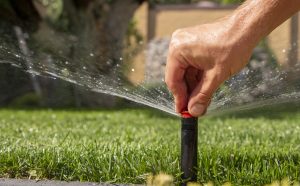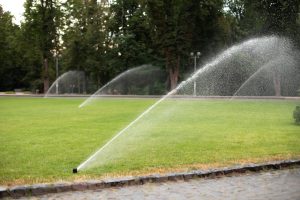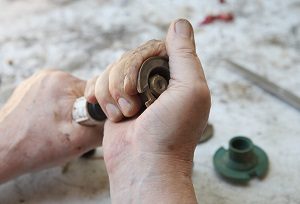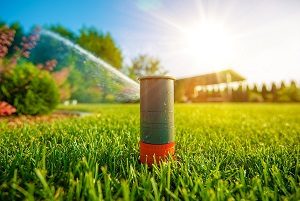 When it comes to irrigation, no two properties are the same, especially when slopes come into play. Sloped landscapes present unique challenges, from runoff to inconsistent water distribution. That’s why choosing the right watering technique for your sloped landscape is essential for maintaining healthy grass, plants, and soil integrity. In this blog, we’ll break down efficient watering techniques for sloped landscapes to help you determine which method best suits your property’s needs.
When it comes to irrigation, no two properties are the same, especially when slopes come into play. Sloped landscapes present unique challenges, from runoff to inconsistent water distribution. That’s why choosing the right watering technique for your sloped landscape is essential for maintaining healthy grass, plants, and soil integrity. In this blog, we’ll break down efficient watering techniques for sloped landscapes to help you determine which method best suits your property’s needs.
Why Slopes Need a Different Approach
When you’re working with a sloped landscape, gravity works against you. Water tends to flow downhill before it has time to absorb, which can lead to:
- Runoff and Erosion: Water can carry away topsoil and nutrients, damaging plants and weakening your landscape.
- Uneven Watering: Upper sections stay dry while lower areas may flood, stressing your plants and wasting resources.
- Shallow Root Systems: Fast-moving water doesn’t soak in deeply, which prevents strong root growth and long-term plant health.
To avoid these issues, it’s important to use watering techniques that allow water to soak in gradually and stay where your plants need it most.
The Best Watering Techniques for Sloped Landscapes
Not all irrigation methods work well on slopes. These are the most effective systems for keeping sloped properties healthy and hydrated:
Cycle and Soak
This method breaks watering into short, repeated cycles with rest periods in between. It allows water time to absorb into the soil before the next cycle begins, helping to reduce runoff and prevent erosion on steep grades.
Drip Irrigation
Drip systems apply water directly to the base of plants, drop by drop. This method works especially well in planting beds along slopes and keeps water from pooling or running off. It’s also highly efficient and easy to customize for different plant zones.
Rotary Nozzles and Sprinklers
Rotary sprinklers deliver water at a slower, more controlled rate than traditional spray heads. This reduces runoff and ensures that more water reaches the soil. They’re a solid choice for moderate slopes that need broad coverage.
Make Your System Work for Your Landscape
Choosing the right watering techniques for sloped landscapes depends on a range of factors, from soil type and sun exposure to plant variety and slope steepness. The right system will deliver water where it’s needed while reducing waste, erosion, and long-term damage. But irrigation alone isn’t always the full solution. In many cases, proper grading, retaining walls, or hardscape features are necessary to manage water flow and prevent long-term erosion.
At Dolan Landscaping, we design and install irrigation systems that are tailored to your property. Whether you need a full system for a steep incline or a drip setup for garden beds paired with hardscaping and retaining walls, we’ll help you find the right solution for your outdoor space. Call our team at (508) 799-4556 or contact us here for more information.
 This time of year, so many of us are eager to
This time of year, so many of us are eager to  Those who’ve had them installed know sprinkler systems are no small investment. That’s why properly maintaining them throughout the year is key to protecting your investment and saving you money on repairs down the road. A crucial part of this routine maintenance and seasonal care is the winterization process. Let’s break down why it’s necessary to winterize your sprinkler system.
Those who’ve had them installed know sprinkler systems are no small investment. That’s why properly maintaining them throughout the year is key to protecting your investment and saving you money on repairs down the road. A crucial part of this routine maintenance and seasonal care is the winterization process. Let’s break down why it’s necessary to winterize your sprinkler system. When the ground freezes, so can your irrigation system. From sprinkler heads to in-ground pipes, when irrigation components freeze, any remaining water inside can freeze too. Forgot to perform winterization on your irrigation systems? This can cost you as that water expands when freezing into ice, warping and cracking your pipes and sprinkler heads. Below we look at the two most common issues on irrigation systems after winter, and what it takes to solve them.
When the ground freezes, so can your irrigation system. From sprinkler heads to in-ground pipes, when irrigation components freeze, any remaining water inside can freeze too. Forgot to perform winterization on your irrigation systems? This can cost you as that water expands when freezing into ice, warping and cracking your pipes and sprinkler heads. Below we look at the two most common issues on irrigation systems after winter, and what it takes to solve them.  There are many options to choose from when it comes to irrigation for your home or business, and it is a vital part of maintaining great lawns and plantings. From soaker hose and drip irrigation lines to keep gardens and other plants watered in the most efficient way, to sprinkler/spray systems, all the way to industrial-strength rotor systems for large estates or commercial lawns. Today we’ll look at the most commonly installed system: the lawn sprinkler system, and see how they work and why they are a good fit for most irrigation needs.
There are many options to choose from when it comes to irrigation for your home or business, and it is a vital part of maintaining great lawns and plantings. From soaker hose and drip irrigation lines to keep gardens and other plants watered in the most efficient way, to sprinkler/spray systems, all the way to industrial-strength rotor systems for large estates or commercial lawns. Today we’ll look at the most commonly installed system: the lawn sprinkler system, and see how they work and why they are a good fit for most irrigation needs.